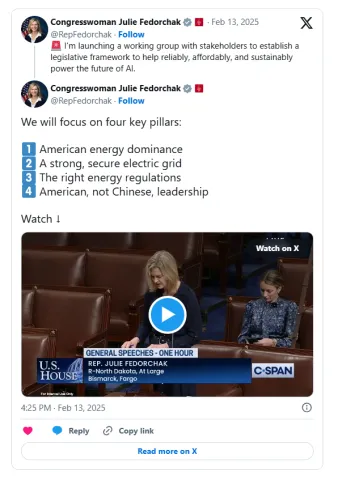Fedorchak announces working group to establish legislative framework to power the future of AI
Washington, D.C. — Congresswoman Julie Fedorchak (R-ND) today announced she is creating a working group of stakeholders dedicated to powering the future of AI. This group will focus on four key pillars aimed at developing a legislative framework to that will reliably, affordably, and sustainably power this growing technology.
Below are her remarks are prepared for delivery:
Mr. Speaker, we’ve talked a lot about the challenges that face American energy, but I want to talk about the opportunities we have, too.
With an energy supply that is affordable, reliable, and dependable, the United States can lead the way on emissions reduction and Artificial Intelligence.
Today, I want to talk about AI. But to be AI dominant, we must first be energy dominant.
That is why today, I am announcing my plans to create an AI and Energy Working Group.
While my colleagues are thankfully working hard on regulation, speech, and other components of AI, this working group will focus exclusively on AI and the energy this growing technology demands.
This work will be complementary to, and not duplicative of, other efforts by my colleagues, including the Speaker’s Task Force on AI which completed its work last December.
My goal is to bring in experts and stakeholders, legislators, and other interested parties to fully explore these power needs, current barriers to meet it, and federal policy solutions to help reliably, affordably, and sustainably power the future of AI.
I plan to follow four main pillars.
First, meeting AI energy demands requires American energy dominance.
Today, AI searches consume nearly ten times the electricity of standard internet searches.
In 2024, data centers accounted for 4.3% of the total U.S. power demand, and analysts predict this could climb to as much as 12% by 2030.
To put that into perspective, that would be more electricity than the entire state of Texas uses today.
Yet, the U.S. isn't scaling up reliable baseload power quickly enough to support this rapid growth.
In fact, Biden administration policies are forcing this base load power offline!
If we don’t act, we risk energy shortages, higher costs, and a slowdown in technological advancement.
To secure their energy needs, major tech companies are locking in exclusive long-term power contracts.
For example, in September 2024, Microsoft entered an agreement to reopen the Three Mile Island nuclear power plant to reliably power its AI data center.
While I support these types of agreements, we must also ensure that smaller companies and new players in the AI industry have access to the power they need to innovate and compete.
Meeting the energy demands of AI isn’t just about powering technology—it's about powering America’s future.
Which brings us to pillar two, a Strong, Secure Electric Grid.
The rapid, forced transition to intermittent power sources—paired with the retirement of reliable baseload generators—has left our electric grid increasingly vulnerable to outages.
Today, the North American Electric Reliability Corporation warns that two-thirds of the United States faces an elevated or high risk of blackouts.
And as we become more reliant on power-dependent digital infrastructure, the stakes are even higher.
But having enough power isn’t our only concern.
Cyberattacks targeting U.S. grid operations and infrastructure are a growing threat that could disrupt everything from everyday conveniences to national security.
If AI is to flourish, we must prioritize grid reliability and security.
This requires the Right Energy Regulations, which is pillar three.
According to the Bipartisan House Task Force Report on Artificial Intelligence, new AI models are developed roughly every six months, and data centers are built within one to two years.
Meanwhile, new power plants and transmission infrastructure can take at least 5-10 years to build.
This creates a significant gap between the rapid growth of AI and the power supply needed to support it.
Our current energy regulatory environment is not equipped to bridge this gap.
We need forward-thinking regulations that empower both small innovators—who depend on the bulk power system—and larger firms that secure power through long-term agreements.
By ensuring a level energy playing field, we can position America as the global leader in AI development and outpace China.
And that leads us to pillar four.
America, not China, must be the global leader of AI Innovation.
On January 20th of this year, China unveiled DeepSeek-R1, its most advanced Large Language Model, reportedly developed with less advanced processors at a fraction of the cost of U.S. models.
This proves that China is rapidly closing the gap, and we cannot afford to fall behind.
The Trump administration recognizes this urgency.
Just three days later, on January 23, President Trump signed Executive Order 14179, “Removing Barriers to American Leadership in Artificial Intelligence.”
This order overturned President Biden’s mandates that had stifled American investment and innovation in AI.
With this decisive action, we’re reclaiming our competitive edge.
It’s time to take the handcuffs off our AI industry and unleash the full potential of American ingenuity.
Winning the future of AI requires bold action, smart energy policy, and a commitment to American innovation.
That’s why I will engage with a broad range of voices and stakeholders—big and small—to craft a legislative framework that secures our energy dominance, strengthens our electric grid, and positions America as the global leader in AI.
For those with ideas on how we can achieve these goals, my door is always open.
Together, we can power the future of AI and ensure that America—not China—leads the way.
With that, Mr. Speaker, I yield back.
If you’re a stakeholder interested in being a part of the working group, please contact Ty Kennedy.
###
